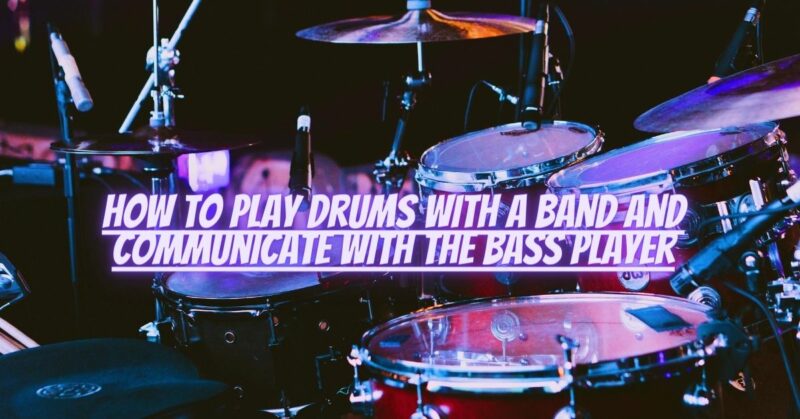The rhythm section formed by the drums and bass is the backbone of any band. As a drummer, developing a strong musical connection and effective communication with the bass player is vital for creating a tight and cohesive rhythm foundation. In this article, we will explore essential techniques and strategies to help you play drums with a band and establish clear communication with the bass player. From establishing a rhythmic pocket to using visual and aural cues, we’ll cover key aspects that will enhance your musical collaboration and elevate the band’s groove.
- Establish the Rhythmic Pocket: The drummer and bass player must work together to establish a solid rhythmic pocket. Focus on locking in with the bass player’s timing and groove by listening closely to their playing. Pay attention to the bass player’s note placement and feel the weight of their notes. Adapt your drumming to complement the bass player’s rhythm, reinforcing and enhancing the overall groove of the music.
- Share Visual Cues: Visual cues play a crucial role in nonverbal communication between the drummer and bass player. Establish eye contact and use subtle gestures to communicate specific musical cues and transitions. Visual cues can signal changes in dynamics, upcoming fills, or shifts in rhythmic patterns. Develop a shared understanding of these cues through rehearsal and regular performance together.
- Use Aural Cues: Listening and responding to aural cues is essential in playing drums with a bass player. Pay attention to the subtle nuances and variations in the bass player’s playing, such as accents, slides, or rhythmic phrasing. Respond to these cues by adjusting your drumming accordingly, adding accents, or creating complementary rhythmic patterns. Developing a keen ear for the bass player’s playing style allows for a more cohesive and synchronized rhythm section.
- Maintain Clear Communication: Open and clear communication with the bass player is key to establishing a strong musical connection. Discuss song arrangements, dynamics, and desired feels during rehearsals. Share ideas, suggestions, and feedback with each other to find common ground and enhance the band’s overall performance. Encourage an environment where everyone feels comfortable expressing their musical ideas and concerns.
- Respect Each Other’s Space: Respecting each other’s musical space is crucial when playing drums with a bass player. Avoid excessive busyness or competing with the bass player’s melodic lines. Instead, focus on providing a solid rhythmic foundation that supports the bass player’s playing and allows their musical ideas to shine. Emphasize the rhythmic aspects of your drumming, complementing and enhancing the bass player’s melodic and harmonic choices.
- Practice Together: Regular rehearsals are essential for developing a strong musical connection with the bass player. Set aside dedicated practice time to play together, focusing on rhythmically tight sections, transitions, and specific musical arrangements. Use this opportunity to experiment with different grooves, fills, and dynamic variations, exploring how they interact with the bass player’s playing. The more you practice together, the stronger your musical connection will become.
- Study Rhythm Section Recordings: Study recordings of renowned rhythm sections to understand the dynamics and communication between drummers and bass players. Analyze the interplay, rhythmic nuances, and the overall feel they create together. Pay attention to their shared sense of timing, pocket, and groove. Incorporate elements from these recordings into your own playing, adapting them to fit your band’s musical style.
- Develop a Sense of Trust: Building trust with the bass player is essential for a solid rhythm section. Trust that the bass player will hold down the harmonic foundation, and they trust that you will provide a strong rhythmic foundation. Give each other room to express and explore within the music, knowing that you are working together to create a cohesive sound. This mutual trust allows for a more intuitive and seamless musical connection.
- Perform Live Together: Performing live with the bass player is where the musical connection truly comes alive. Embrace the energy of the performance and feed off each other’s playing. Maintain active listening throughout the performance, adapting your drumming to the bass player’s nuances in real-time. Engage in musical conversations, exchanging ideas and improvisational elements that enhance the overall performance.
Conclusion: Playing drums with a band and effectively communicating with the bass player is essential for creating a tight and cohesive rhythm section. By establishing a rhythmic pocket, using visual and aural cues, maintaining clear communication, respecting each other’s musical space, practicing together, studying rhythm section recordings, developing a sense of trust, and performing live together, you can elevate the band’s groove and musicality. Embrace the role of the rhythm section as the foundation of the band, and let your collaborative efforts with the bass player create a powerful and unified musical force.


